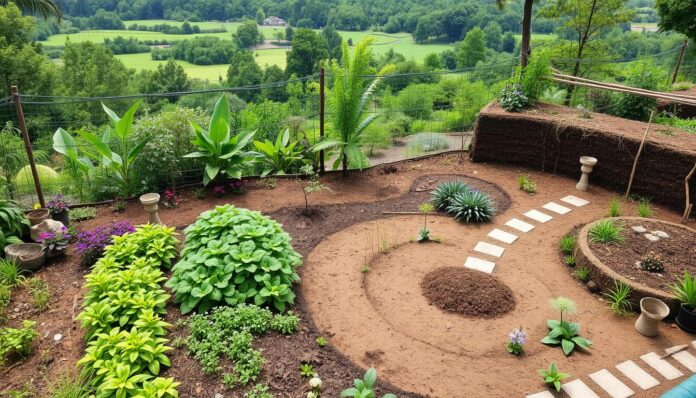Imagine turning our waste into something valuable. This idea fuels a permaculture circular economy that supports sustainable agriculture and regenerative design. It’s about making closed cycles where every product we use helps a bigger, greener system. By embracing permaculture and the circular economy, we can find new ways to manage waste. This helps the environment and our communities.
Looking at where permaculture meets the circular economy, we see a chance for a greener, closed-loop economy. This way not only cuts down on waste but also boosts sustainable farming, regenerative design, and eco-friendly actions. By following these ideas, we can make our planet a better place.
Key Takeaways
- Permaculture promotes sustainable agriculture and regenerative design
- The circular economy focuses on waste management and closed cycles of production
- Combining permaculture and the circular economy can create a more sustainable system
- Efficient composting systems are crucial for permaculture and the circular economy
- Implementing permaculture practices can improve soil health and reduce waste
- Sustainable agriculture and regenerative design can benefit from permaculture and the circular economy
Introduction to Permaculture Composting Systems
Permaculture is a way to design sustainable ecosystems. It aims to reduce our ecological footprint. By using green technology and focusing on environmental sustainability, we can improve ecosystem health and biodiversity.
Permaculture emphasizes caring for the environment and treating people fairly. It encourages us to think differently about waste and our relationship with nature.
What is Permaculture?
Permaculture is a design system that aims to reduce waste and increase efficiency. It follows the principles of environmental sustainability. By adopting permaculture, we can lower our ecological footprint and help create a sustainable future.
Importance of Composting in Permaculture
Composting is key in permaculture. It turns waste into a valuable resource that boosts soil fertility and ecosystem health. By composting regularly, we can cut down on synthetic fertilizers and lessen our environmental impact. This supports environmental sustainability and green technology.
Types of Composting Systems
Composting is key to sustainable agriculture. It helps reduce waste and fight climate change. Different composting systems offer unique benefits and challenges.
Traditional composting is a common method. It involves collecting organic materials and letting them decompose. This method is great for reducing waste and making soil rich in nutrients. Sustainable agriculture practices like composting cut down on synthetic fertilizers.
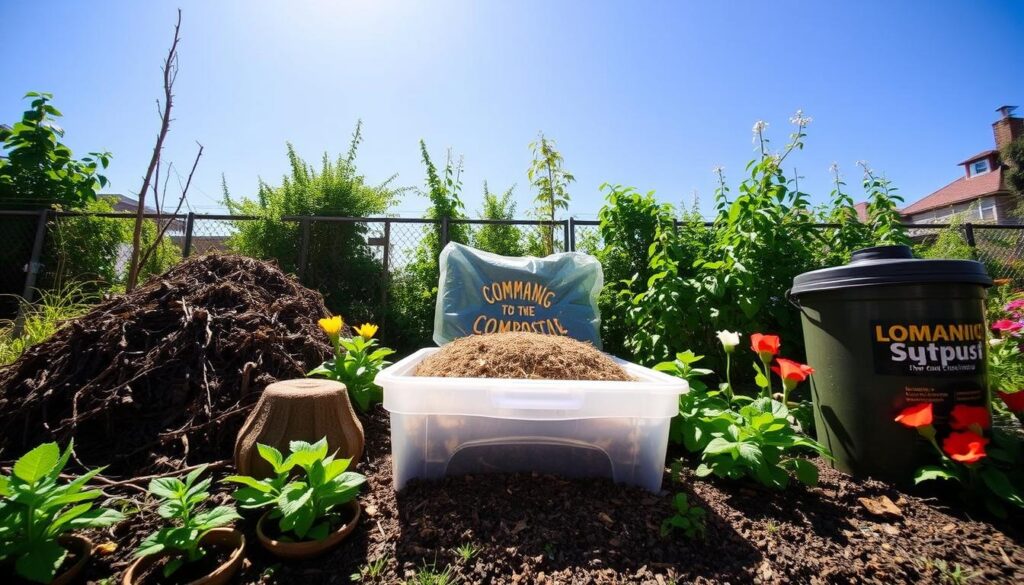
Traditional Composting
Traditional composting is easy and affordable. It’s done at home by collecting organic materials. It’s perfect for small-scale composting and making nutrient-rich soil.
Bokashi Composting
Bokashi composting uses microorganisms to break down organic matter. It’s great for composting meat and dairy. It’s a good choice for those without space for traditional composting.
Vermicomposting
Vermicomposting uses worms to break down organic matter. It’s ideal for indoor composting of food waste. It’s a way to make nutrient-rich soil and reduce landfill waste.
In conclusion, composting is vital for sustainable agriculture. There are many composting systems to choose from. By choosing composting, we can fight climate change and build a sustainable future.
Key Principles of Composting
Composting is key in regenerative design, cutting down waste’s ecological footprint. It uses green technology and composting to lessen environmental harm. It turns organic waste into nutrient-rich soil.
The carbon-to-nitrogen ratio is crucial in composting. It balances “green” materials like food waste with “brown” materials like leaves. This balance is vital for microbes to break down the waste.
Aeration and moisture are also important. Compost piles need oxygen and water for microbes to grow. Regularly turning the pile and keeping it moist helps. This way, people can make quality compost, cutting down on synthetic fertilizers and waste.
Composting has many benefits. It reduces waste, makes soil rich in nutrients, and helps local ecosystems. By composting, people help the planet and reduce their ecological footprint. As we move towards more sustainable living, composting will become even more vital.
Setting Up a Composting System
Creating a composting system is key to helping our planet. It’s a way to fight climate change and make our agriculture more sustainable. To do it right, you need to pick the right spot, choose the right bin, and layer your materials correctly.
A good composting system cuts down on harmful gases and makes soil better for plants. It can also cut down on waste and save money. Plus, it means you don’t need to use harmful chemicals to grow food.
Location Considerations
When picking a spot for your compost, think about how easy it is to get to, if it drains well, and if it’s close to water. It should also get enough air and sunlight. The right spot makes composting easier and helps the environment.
Container Options
You can use many things for composting, like wooden pallets, wire cages, or plastic bins. Think about how long it will last, how easy it is to use, and how it looks. A good bin keeps your compost area tidy and makes it simpler to take care of.
Layering Materials
Layering your compost is important. Mix “green” stuff like food scraps and grass with “brown” stuff like leaves and sticks. This keeps the compost healthy and helps plants grow. By following these steps, you can make compost that’s good for the earth and fights climate change.
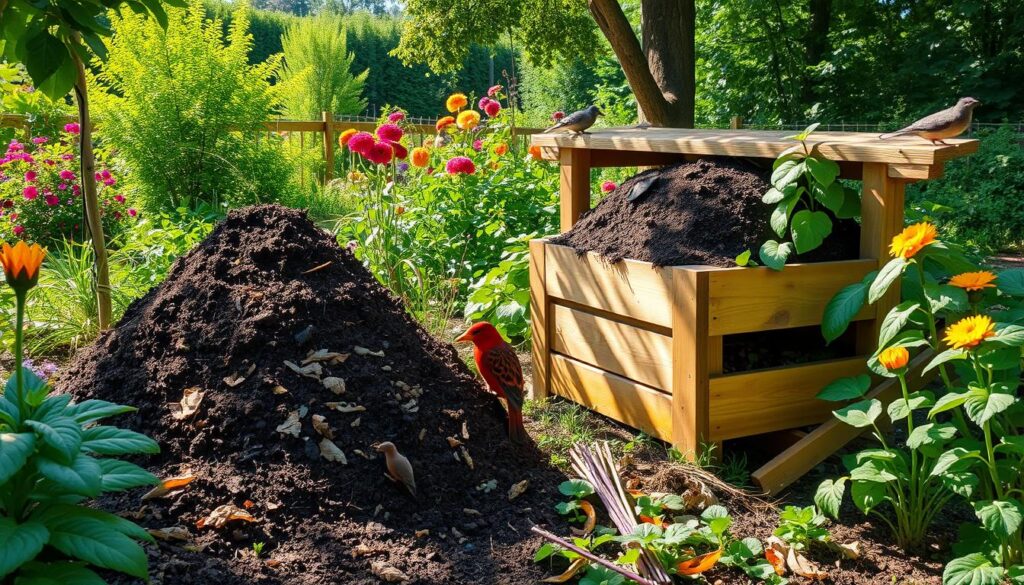
| Composting Benefits | Environmental Impact |
|---|---|
| Reduces greenhouse gas emissions | Supports climate change mitigation |
| Conserves water | Promotes water conservation |
| Creates nutrient-rich soil amendments | Supports sustainable agriculture |
Using Kitchen Waste in Composting
Kitchen waste is a great resource for composting. It helps reduce landfill waste and makes soil rich in nutrients. By using kitchen waste in a permaculture circular economy, we can lower our ecological footprint. A good composting system, based on regenerative design, turns kitchen waste into quality compost.
Items like fruit and veggie scraps, tea bags, and eggshells are good for composting. But, avoid adding meat, dairy, and oily foods. They can attract pests and smell bad. A mix of “green” and “brown” materials in the compost pile keeps it healthy and rich.
Composting kitchen waste helps us move towards a sustainable future. The USDA says community composting can cut down greenhouse gas emissions. Together, we can build a food system that values waste reduction and soil health.
Enhancing Compost Quality
We need to find ways to make compost better for the environment. Using green technology in composting can make it more efficient. This includes adding soil inoculants or effective microorganisms to speed up decomposition.
Studies show that permaculture sites have 27% more soil carbon than control fields. This shows how permaculture can help fight climate change. By using these methods, we can lower our carbon footprint and support a sustainable food system.
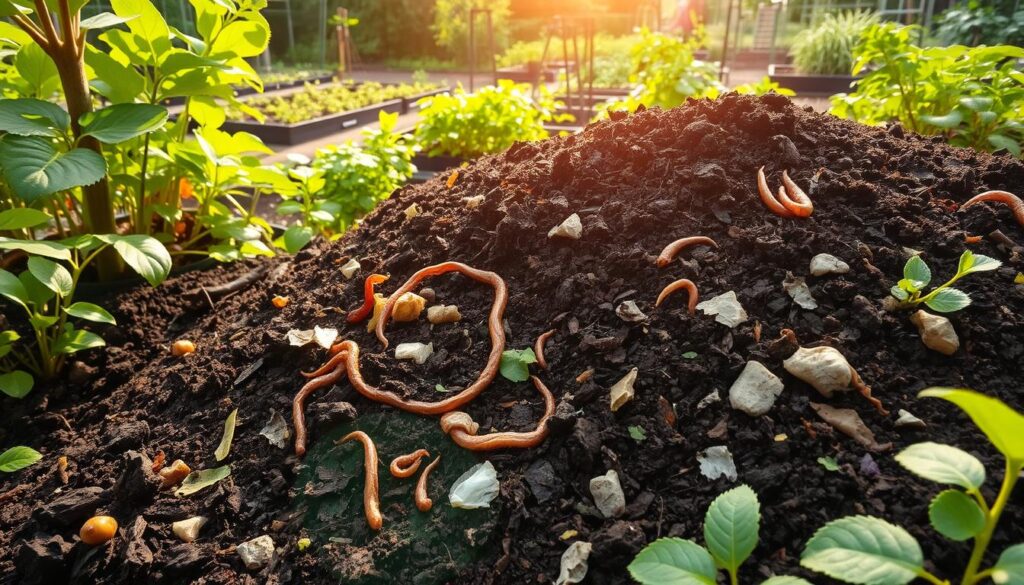
Improving compost quality has many benefits. It makes soil more fertile and improves ecosystem health. It also boosts crop production and cuts down on greenhouse gases.
By focusing on these areas, we can build a more sustainable food system. This is key for protecting the environment and reducing climate change.
Maintaining Your Compost Pile
Keeping your compost pile in good shape is key for it to work well. This supports sustainable agriculture practices. You need to turn the pile and check the temperature and moisture levels. This creates the best environment for microbes to thrive.
Turning the pile helps speed up decomposition and stops bad smells. It’s also important to watch the temperature and moisture. This keeps the compost pile in the best range for microbes, cutting down on its ecological footprint.
Using regenerative design in composting helps make our food system better. It reduces waste and promotes ecological balance. This not only helps the environment but also supports local food production. It makes our community more resilient and sustainable.
Here are some important tips for compost pile maintenance:
- Turn the pile often to keep it aerated and speed up decomposition
- Check the temperature and moisture levels to help microbes grow well
- Mix “green” and “brown” materials to keep the carbon-to-nitrogen ratio balanced
Troubleshooting Common Issues
When you start composting for the environment, you might face some problems. These include bad smells and pests. But, you can solve these by keeping your composting area clean and understanding how it works. This is key for fighting climate change and making a more sustainable economy.
Some common problems in composting are:
- Odor problems: Often caused by too much nitrogen or moisture, these can be resolved by adjusting the carbon-to-nitrogen ratio or adding more browns to the pile.
- Pests and wildlife: Attracted to food waste, these can be deterred by using secure composting bins or adding a layer of finished compost on top.
By fixing these issues, you help the environment and fight climate change. This way, you also support a new economic system that values reducing waste and using resources wisely. 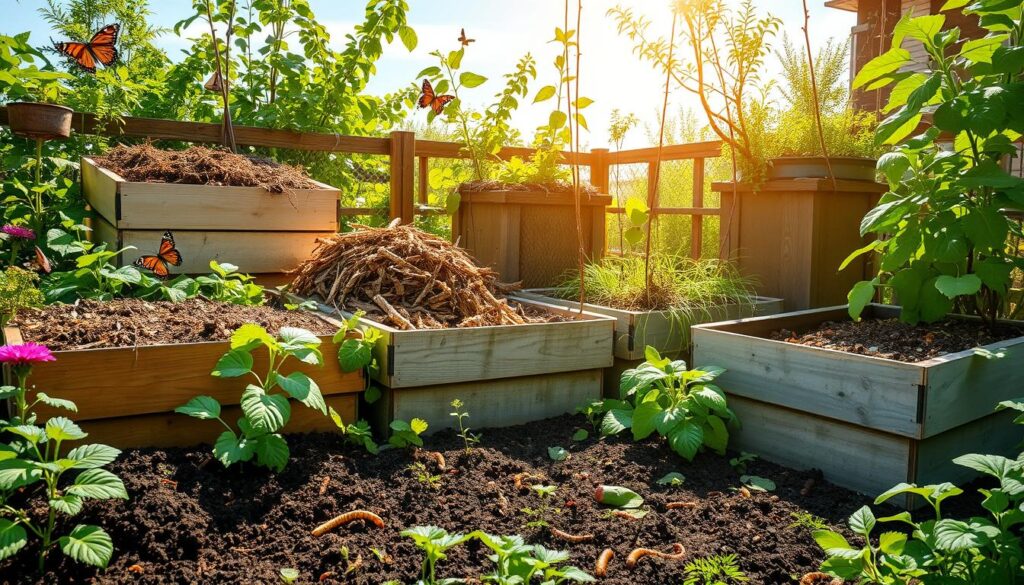
Integrating Compost with Permaculture Practices
Creating a sustainable food system is key. Integrating compost with permaculture is essential. This method reduces waste and supports a regenerative design that’s good for the environment. It helps us lower our ecological footprint and build a more circular economy.
Understanding the benefits of companion planting and soil improvement is crucial. Companion planting pairs plants to help each other grow. This boosts crop yields and biodiversity, vital for a healthy ecosystem. Improving soil fertility lets plants grow well without synthetic fertilizers.
Benefits of compost and permaculture include:
- Improved soil health and fertility
- Increased crop yields and biodiversity
- Reduced waste and ecological footprint
- Promotion of a permaculture circular economy
By using permaculture and compost, we can make our food system more sustainable. This approach cuts down energy use, saves water, and fights climate change. It’s vital to focus on our ecosystem’s health and support a permaculture circular economy.
Research shows permaculture can greatly reduce energy and waste in food production and use. By adopting these practices, we can ensure a sustainable future and a healthier environment for future generations.
| Benefits of Permaculture Practices | Environmental Impact |
|---|---|
| Improved soil health and fertility | Reduced soil erosion and increased carbon sequestration |
| Increased crop yields and biodiversity | Promotion of ecosystem services and reduced pesticide use |
| Reduced waste and ecological footprint | Minimized greenhouse gas emissions and conserved natural resources |
Harvesting and Using Compost
Composting is key in sustainable farming. It cuts down waste and makes soil full of nutrients. Knowing when compost is ready is very important.
Compost is ready when it smells earthy, is dark, and breaks down easily. There are many ways to use compost. You can mix it into soil, use it as mulch, or make compost tea.
These methods make soil better, help plants grow, and are good for the environment. By doing this, we help fight climate change and support a circular economy.
Using compost has many benefits. It makes soil better and helps plants grow more. It also means we use less harmful chemicals and supports nature.
- Improved soil structure and fertility
- Increased crop yields and plant growth
- Reduced need for synthetic fertilizers and pesticides
- Support for biodiversity and ecosystem health
As we move towards greener ways, composting is more important than ever. It helps us reduce waste and care for our planet. By composting and supporting sustainable farming, we can make a better future and fight climate change.
Conclusion: The Impact of Composting in Permaculture
Composting is key in permaculture, leading to a greener food system. It follows the permaculture circular economy principles. This way, we can make systems that use less waste and are more eco-friendly.
Composting helps by keeping organic waste out of landfills and cuts down on greenhouse gas emissions. It also makes soil better for growing plants. This approach mirrors nature, helping nutrients cycle and carbon stay in the soil.
Adding composting to permaculture can greatly reduce our food’s ecological footprint. Techniques like vermicomposting can lower emissions by up to 40%. Using compost also makes soil better at holding water and nutrients, making ecosystems stronger and more self-sufficient.
As we face climate change and use up resources, permaculture and composting are solutions. They help our soils and food systems get healthier. They also help our planet overall.

